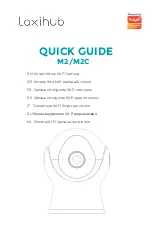
Note:
The orientation of the ThinkStation
®
logo plate on the front of your computer is adjustable. When you
lay the computer on its side, you can slightly pull out the logo plate. Turn it 90-degree counterclockwise,
and then push it back in.
1
Optical-drive eject/close button
Press the button to eject or close the tray of the optical drive.
2
Power button
Press the power button to turn on your computer. If your computer is unresponsive, you can turn off the
computer by pressing and holding the power button for four or more seconds.
3
Power indicator
When the power indicator is on, the computer is turned on.
4
Hard-disk-drive activity indicator
Indicate the status of the internal storage drives (such as hard disk drives or solid-state drives).
On:
The storage drives are ready for use.
Off when computer powered on:
The storage drives do not work properly or other problems occur.
5
Diagnostic indicator
On:
The diagnostic USB 3.0 connector functions as a normal USB 3.0 connector.
Blinking:
A system error is detected or the error-related event log is downloading from the diagnostic
USB 3.0 connector.
6
SD card slot
Insert a secure digital (SD) card into the slot so that the data on the card can be accessed and read.
7
Diagnostic USB 3.0 connector
When a system error is detected, the diagnostic indicator blinks. In this case, if you connect an FAT32
format USB flash drive to the connector, the error-related log can be automatically downloaded from the
diagnostic USB 3.0 connector to the USB flash drive.
8
USB 3.0 connector
Connect a USB-compatible device, such as a USB keyboard, mouse, storage drive, or printer, to this
connector.
9
Always On USB 3.0 connector
Connect a USB-compatible device, such as a USB keyboard, mouse, storage drive, or printer, to this
connector. With the power cord connected, you can charge the connected USB device even when the
computer is in hibernation mode or turned off. If the Always On USB connector function is not enabled,
open the Power Manager program and enable the function. To open the Power Manager program, see
“Accessing a program on your computer” on page 44. To enable the Always On USB connector, refer to
the help system of the Power Manager program.
28
ThinkStation P510 and P710 Hardware Maintenance Manual
Summary of Contents for ThinkStation P710
Page 1: ...ThinkStation P510 and P710 Hardware Maintenance Manual Machine Types 30B4 30B5 30B6 and 30B7 ...
Page 14: ...8 ThinkStation P510 and P710 Hardware Maintenance Manual ...
Page 18: ...12 ThinkStation P510 and P710 Hardware Maintenance Manual ...
Page 19: ...1 2 Chapter 1 Read this first Important safety information 13 ...
Page 20: ...1 2 14 ThinkStation P510 and P710 Hardware Maintenance Manual ...
Page 25: ...1 2 Chapter 1 Read this first Important safety information 19 ...
Page 26: ...1 2 20 ThinkStation P510 and P710 Hardware Maintenance Manual ...
Page 29: ...Chapter 1 Read this first Important safety information 23 ...
Page 40: ...Figure 5 Major FRUs and CRUs 34 ThinkStation P510 and P710 Hardware Maintenance Manual ...
Page 64: ...58 ThinkStation P510 and P710 Hardware Maintenance Manual ...
Page 70: ...64 ThinkStation P510 and P710 Hardware Maintenance Manual ...
Page 96: ...90 ThinkStation P510 and P710 Hardware Maintenance Manual ...
Page 104: ...98 ThinkStation P510 and P710 Hardware Maintenance Manual ...
Page 198: ...192 ThinkStation P510 and P710 Hardware Maintenance Manual ...
Page 202: ...196 ThinkStation P510 and P710 Hardware Maintenance Manual ...
Page 204: ...198 ThinkStation P510 and P710 Hardware Maintenance Manual ...
Page 208: ...202 ThinkStation P510 and P710 Hardware Maintenance Manual ...
Page 212: ...206 ThinkStation P510 and P710 Hardware Maintenance Manual ...
Page 216: ...210 ThinkStation P510 and P710 Hardware Maintenance Manual ...
Page 219: ......
Page 220: ......
















































